COMP4350/8350
Sound and Music Computing
Advanced Synth Design
Yichen Wang & Dr Charles Martin
Outline
- Filters (analogue, digital,
vcf~,bob~, filter math (light) - Subtractive Synthesis (from phasor to Moog Model-D clone))
- FM Synthesis (recall week 3, feedback, algorithms, operator-based design)
- Phase Vocoder + spectral synthesis.
Subtractive Synthesis
Subtractive Synthesis
Let’s take a complex sound and remove some content.

Popular Subtractive Synths
Subtractive synthesis is often used in analogue synth designs, particular with those associated with Bob Moog (famous synth designer).
E.g.,:
- Minimoog Model-D (1970)
- Moog Mother 32 (2015) ~AUD1100
- Korg Volca Keys (2013) ~AUD250
- Arturia Microfreak (2014) ~AUD550
It’s good for analogue designs because you can get a lot of timbral variation out of few (2 or 3) basic oscillators.
Subtractive Synth Layout
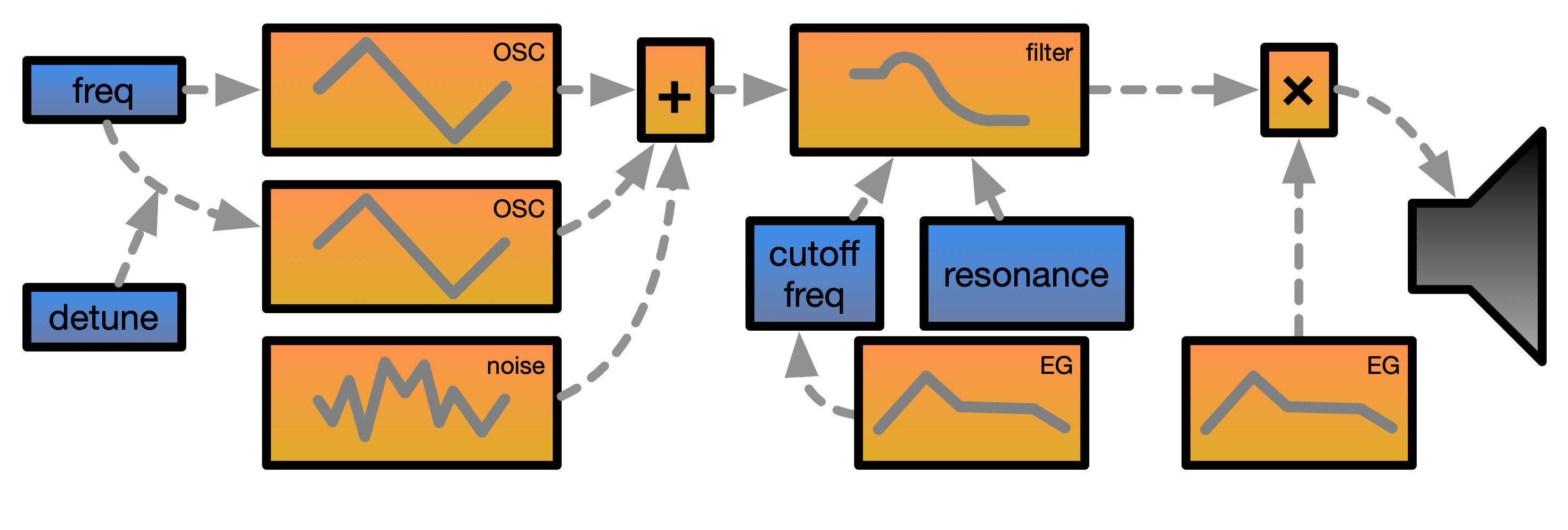
- Sound is produced by 1+ summed oscillators and/or noise generator, processed by filter
- Two envelope generators: output volume and to change the filter cut-off frequency
- Missing: low frequency oscillator for modulation
Minimoog in Pd

Here’s a basic design for an analogue synthesiser with two sawtooth oscillators.
- “detune” changes the frequency of the second oscillator, try a number close to 1, e.g., 1.05 for a rich phase-y sound.
- the filter env gives the sound a nice changing timbre over a note
- for extra fun, try the
bob~object. Similar tovcf~but modelled on actual Moog filter designs.
N.B.: the synthesis part here is quite simple, but processing note information is tricky and requires lots of supporting objects.
FM Synthesis
Simple two-oscillator FM
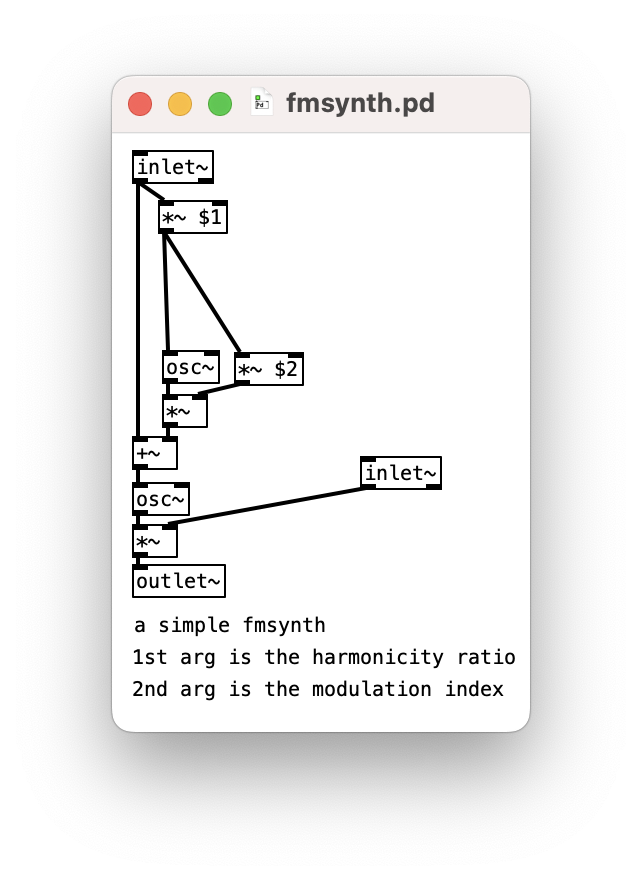
We introduced FM synthesis earlier in the course as a way to make interesting sounds with just two oscillators.
This fmsynth.pd patch has been used a lot!
-
$1is harmonicity (modulation frequency divided by carrier frequency) -
$2is the index (modulation depth divided by modulation frequency)
This allows us to create a consistent timbre for any frequency input. Can we do more with more oscillators?
Revision: Phase Modulation

Let’s just revise how “frequency modulation” works.
- FM can be implemented by modifying the phase of an oscillator.
- In this patch, the phase is modified in between the
phasor~andcos~objects.
FM Operators

We can take the concept of a phase-modulation oscillator and abstract to a reuseable unit: an FM operator.
- An op can serve as a carrier, or as a modulator.
- An op can self-modulate (crazy sounds).
Combining multiple oscillators allows lots of sounds to work together. Typical FM synths will have 4 or 6 operators.
In FM lingo, the wiring diagram between operators is called an algorithm.
Implementing 6-op FM
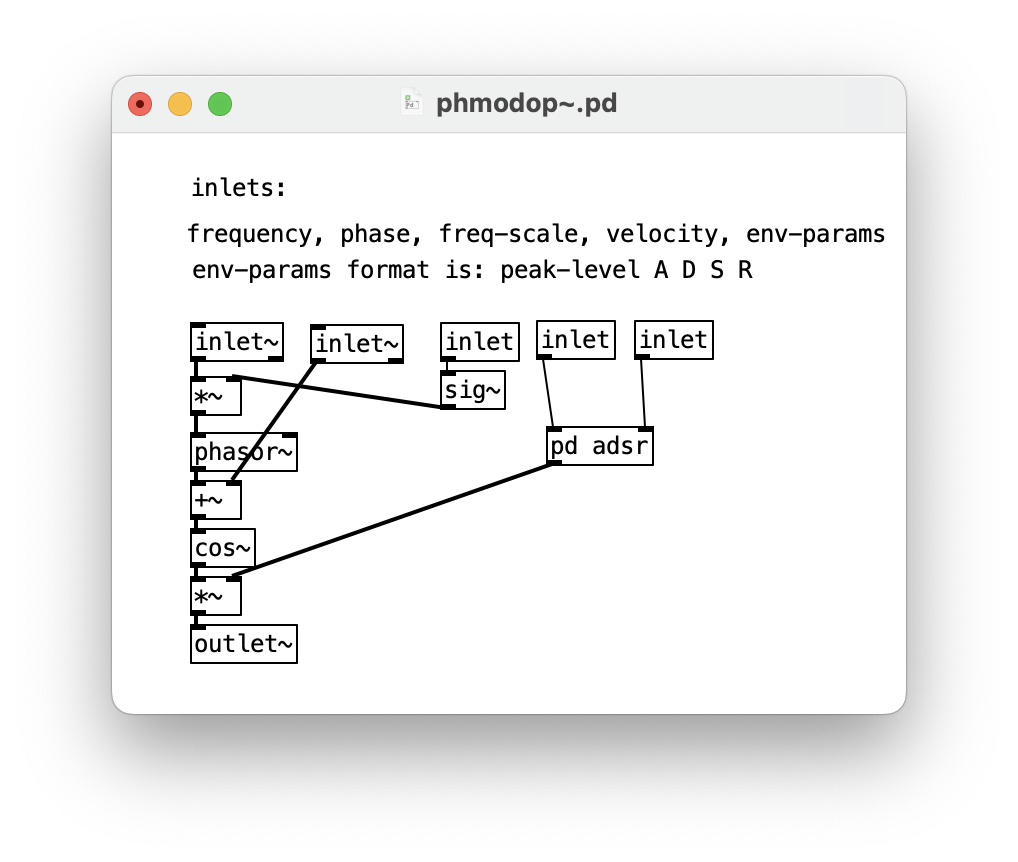
Each operator needs:
- an envelope generator
- amplitude and envelope parameters
- some pitch-ratio control
- pitch ratio parameters
This gets complicated quickly…
Volca FM has 23 parameters per operator, and 16 global parameters, that’s 154 params for one patch!
Operator Layout
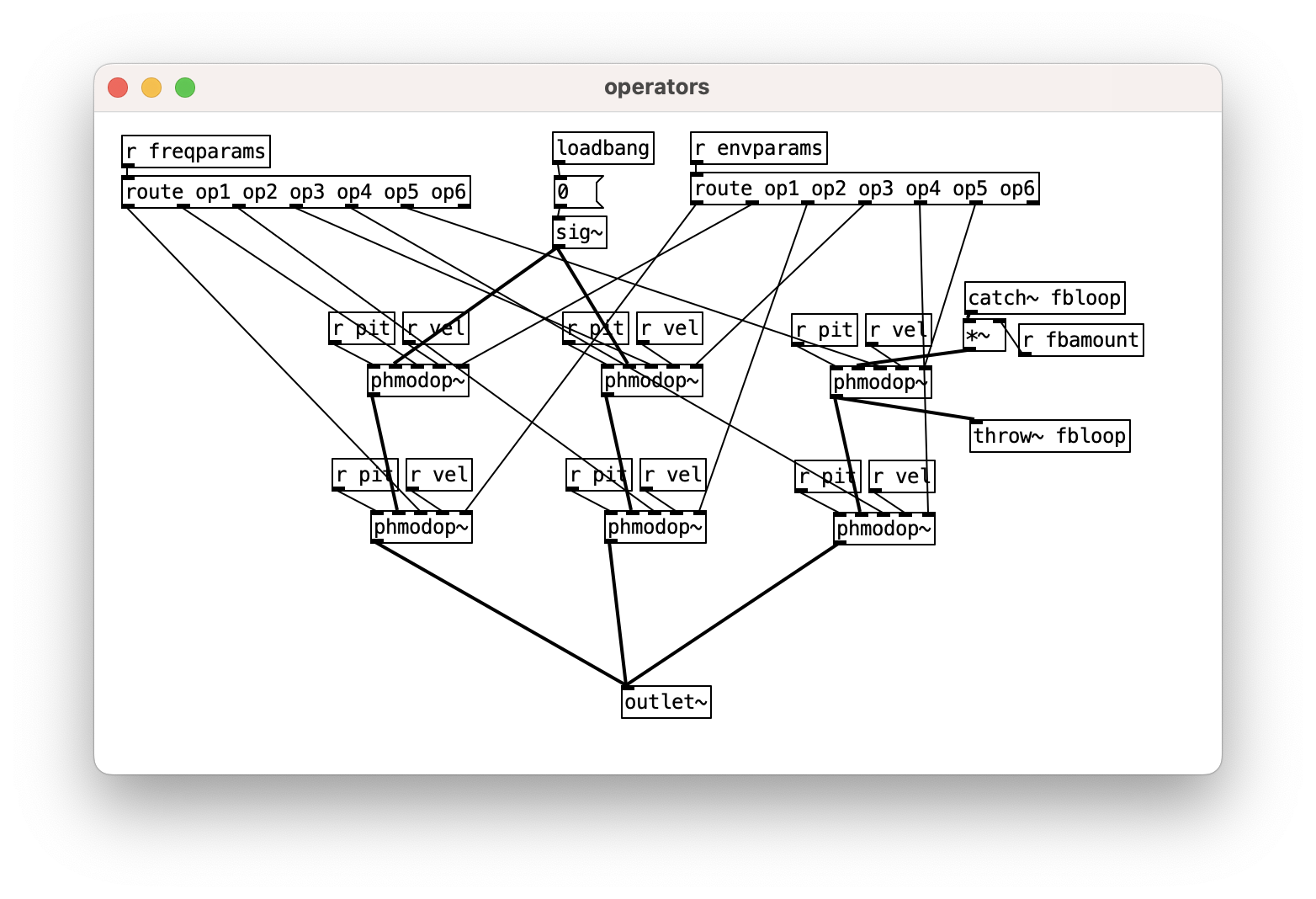
And here’s how you could wire them together…
- note that every op gets the pitch and velocity signals
- using
randrouteto send freq scaling and envelope parameters -
throw~andcatch~for the feedback loop on operator 6.
This is a fixed configuration, could you design a way to control the FM algorithm with parameters?
Commercial FM Synths

Op-based FM is very popular. The Yamaha DX7 was the first successful digital synthesiser in 1983 and Yamaha’s FM sound chips were found in computers and video game consoles throughout the late 80s and 90s.
- Yamaha DX7 (1983)
- Yamaha reface DX (2015) ~AUD600
- Korg Volca FM (2016) ~AUD250
- Elektron Digitone (2017) ~AUD1350
- dexed FM Plugin (modeled on DX7) AUD0
See dexed for free FM synth fun.
String Synthesis
Karplus-Strong string synthesis is a famous algorithm for creating a string-like sound with a noise source, a delay and a filter.
It can be considered a special case of digital waveguide synthesis, used for string, tube, and membrane sounds.
K-S synthesis is quite common in digital synthesisers (e.g., Arturia Microfreak) and it’s fun to do in Pd.
Pd String Synthesis

Here’s a simple Karplus-Strong implementation.
- Noise source is some lightly filtered
noise~ -
vline~controls noise entering the delay loop - the
delread~anddelwrite~define the delay loop - the filter is a
lop~, and the loop has feedback of0.999 - changing the length of the delay loop changes the pitch, so this is adjusted by the frequency input
Physical Modelling Synthesis
Physical modelling synthesis is an interesting area with lots of possibilities and challenges.
Have a look at Julius O Smith’s Stanford Courses (Music 420A) to learn more.
Fourier Resynthesis
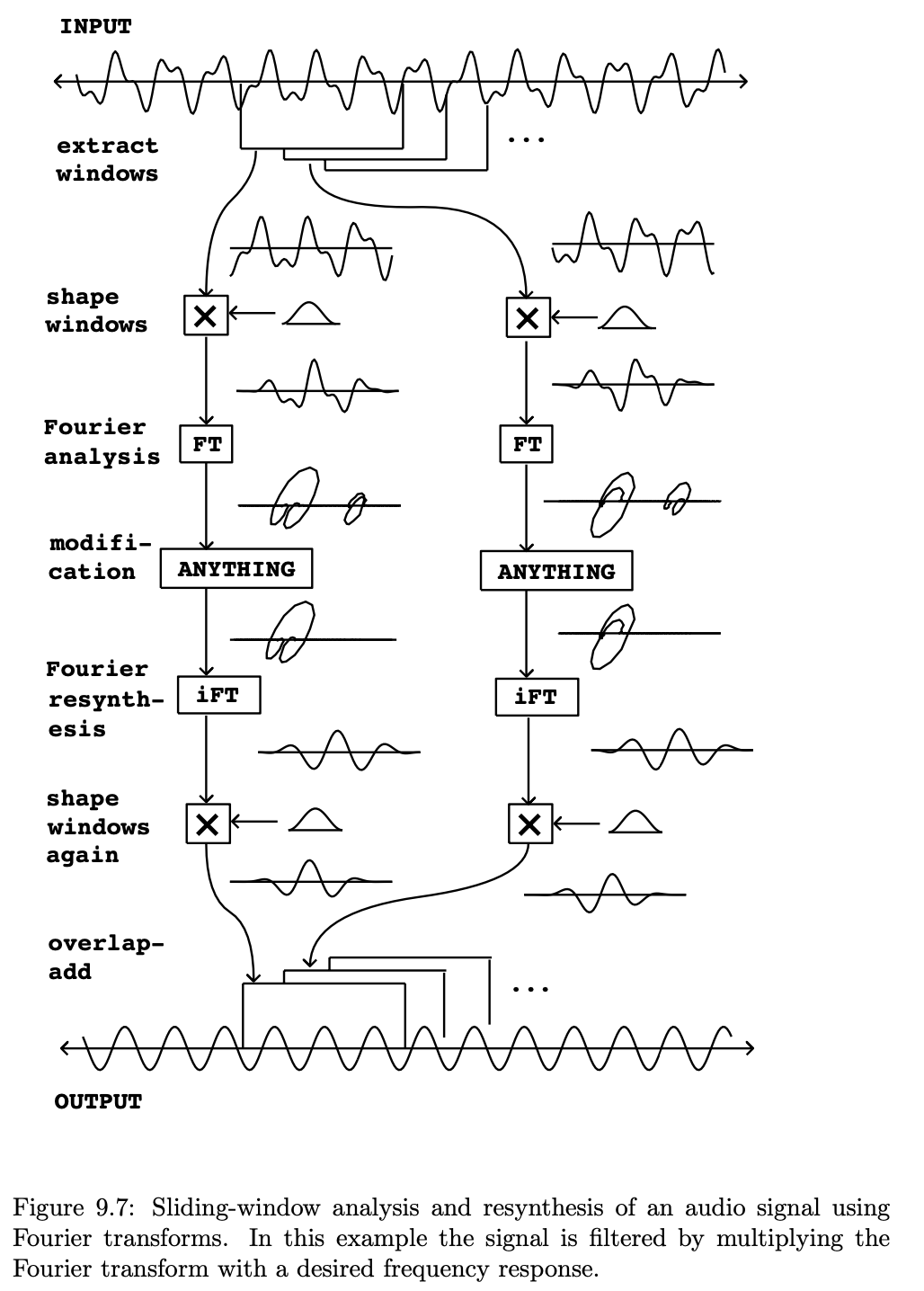
One form of synthesis that is usually limited to computers involves modifying the frequency domain of a sound and recreating new versions.
Spectral manipulation is something that Pd is quite good at doing!
We return a bit to the Fourier transform mentioned early in the course.
For the full story, see Fourier Analysis and Resynthesis in Miller Puckette’s book.
Back to the frequency domain
Remember the Fourier transform? This allowed us to extract the amplitude each frequency component of a sound.
In practice, the FT can’t be used as it requires an infinite input (who has time for that).
We can use a similar construction called: Short-Time Discrete Fourier Transform (STDFT):
-
short-time: operates on a finite-length signal instead of an infinite signal
-
discrete: operates on sampled information
We often refer to SDTFT as FFT, or “fast Fourier transform” (e.g., the fft~ object in Pd).
FFT is actually a clever algorithm for accomplishing a DSTFT quickly, so it’s ok to use the acronyms interchangeably.
Short-Time Discrete Fourier Transform
For a signal with $N$ samples, the STDFT equations providing the sine and cosine amplitudes at certain frequencies are:
-
$R_k = \sum\limits_{i=0}^{N-1} x_i cos(2\pi k i \ N)$
-
$X_k = - \sum\limits_{i=0}^{N-1} x_i sin(2\pi k i \ N)$
The STDFT also only focuses on $N$ frequencies that we call “bins” between 0 and the sampling frequency.
- If the sampling rate is $S$ then the frequency of the $k$th bin is: $k * \frac{S}{N}$
N.B.: the frequency “resolution” is limited by the length of the signal we are analysing!
FFT on a long signal
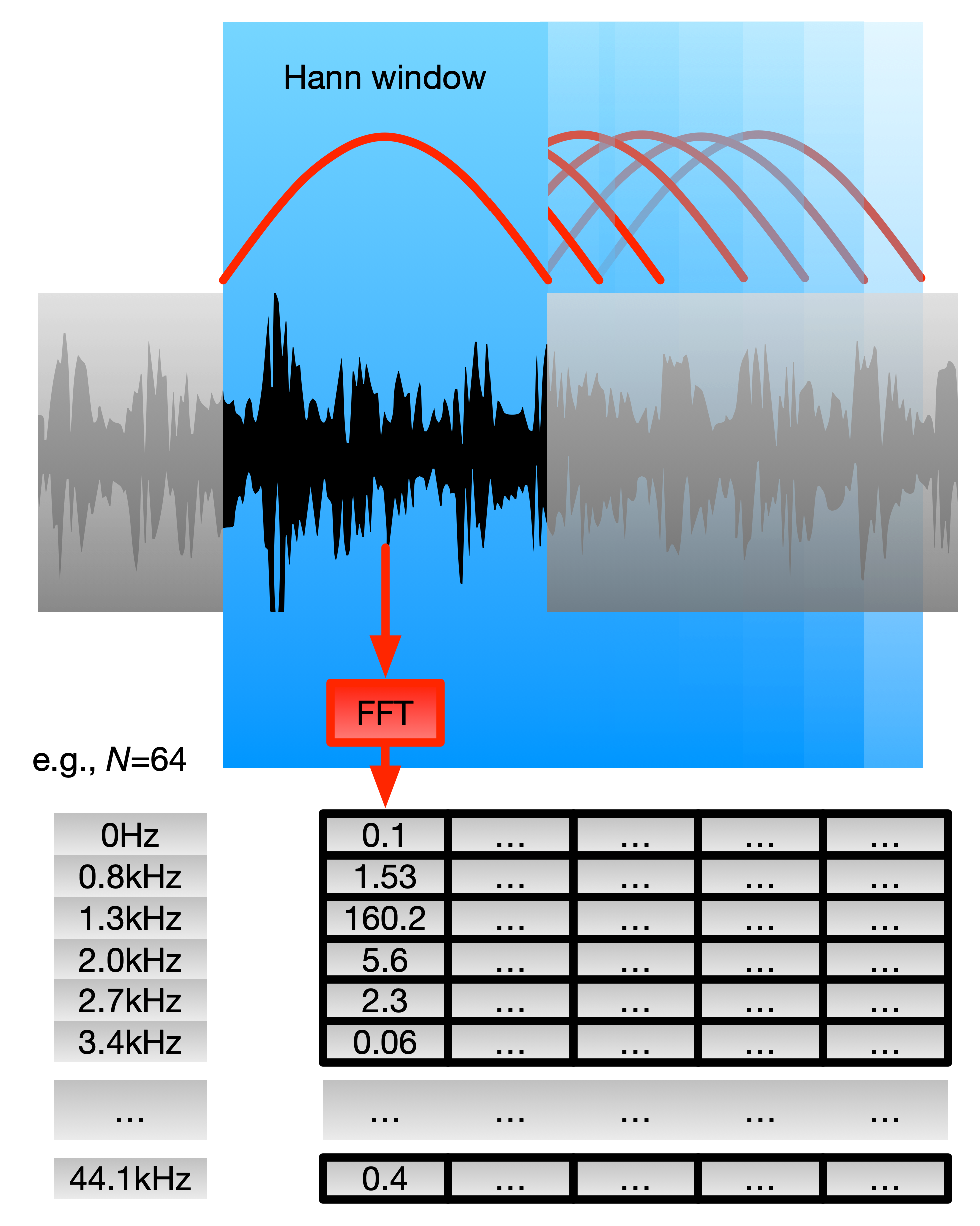
Typically we want to apply FFT to a “chunk” of a signal rather than the whole thing.
Usually we can set the length of the chunk (window length) and an envelope function.
The usual choice for envelope function is the Hann function, it looks kind of like a Gaussian distribution.
The window length is flexible, but will determine the number of frequency bins that can be analysed! Usually the window length is required to be a power of 2 (e.g., 512 or 2048)
Inverse FFT
The FFT procedure actually also works backwards!
- From a finite sequence of frequencies we can (re-)create a sampled signal!
The exclamation mark is doing a lot of work here! Imagine what we can do with full control over a spectrum!!
In fact, the IFFT algorithm is almost identical to the FFT algorithm
It is important when doing an FFT to cope with the sine and cosine elements (or the real and complex outputs of a frequency. These interact in a certain way to make the ouput sound “work”.)
FFT in Pd
Pure Data can perform a STDFT with the fft~ object (yes it’s that easy).
The two outputs give you the real and imaginary part of the signal. You can also do rfft~ just to get the real output (saves CPU).
Similarly, you can do an inverse FFT with rifft~ and ifft~.
In Pd, N is the same as the “block size” (number of samples processed at once), so Pd patches often adjust block size just for the FFT patch to get the right number of FFT bins.
Basic Resynthesis

Here’s a fun way to modify the spectrum of “noise”.
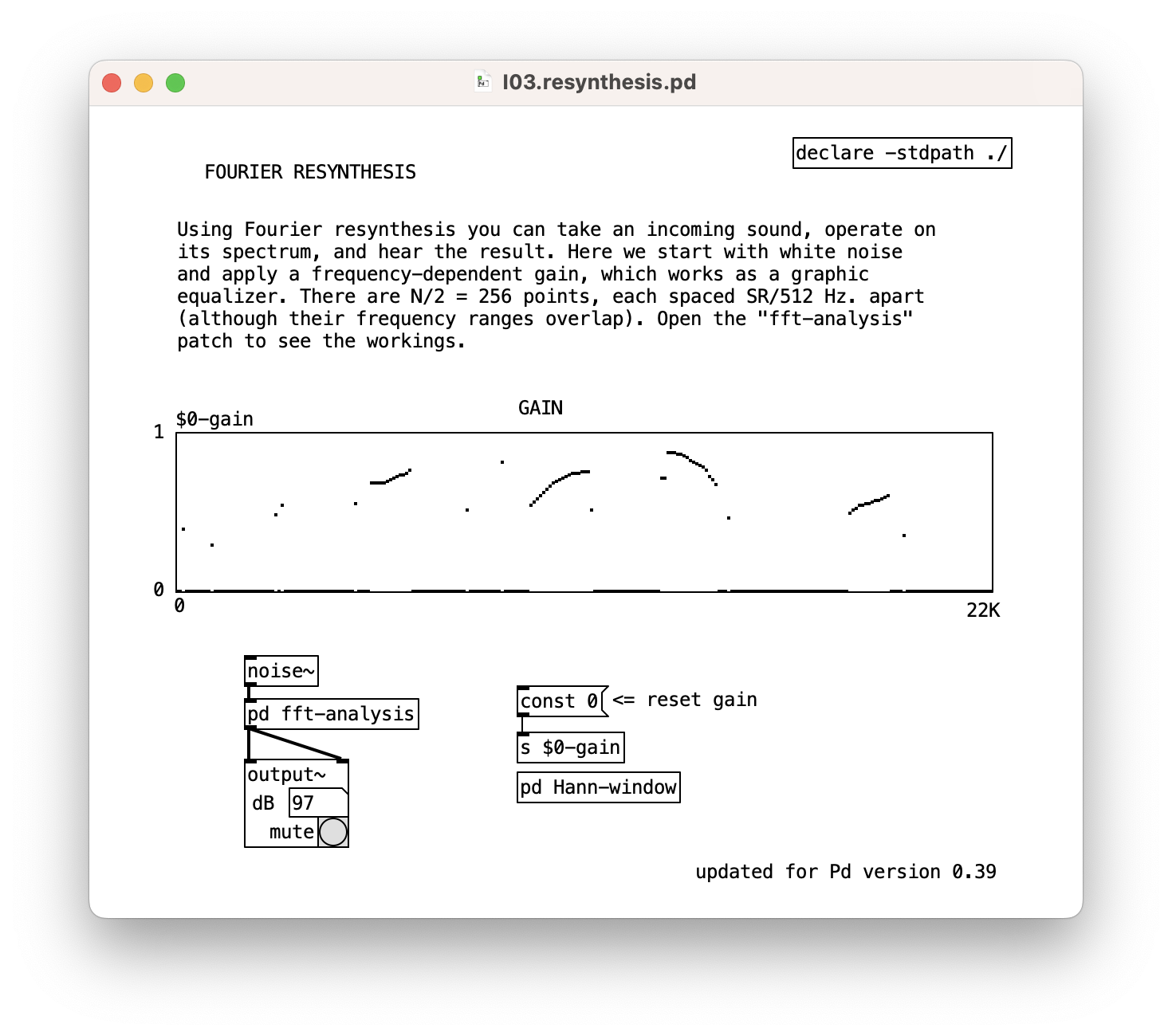
Timbre Stamp

The “timbre stamp” algorithm modulates a signal by the spectral envelope of another sound.
see I06.timbre.stamp.pd
Phase Vocoder

The “phase vocoder” is an algorithm for stretching or compressing the time and frequency axes of a recorded sound.
see I07.phase.vocoder.pd